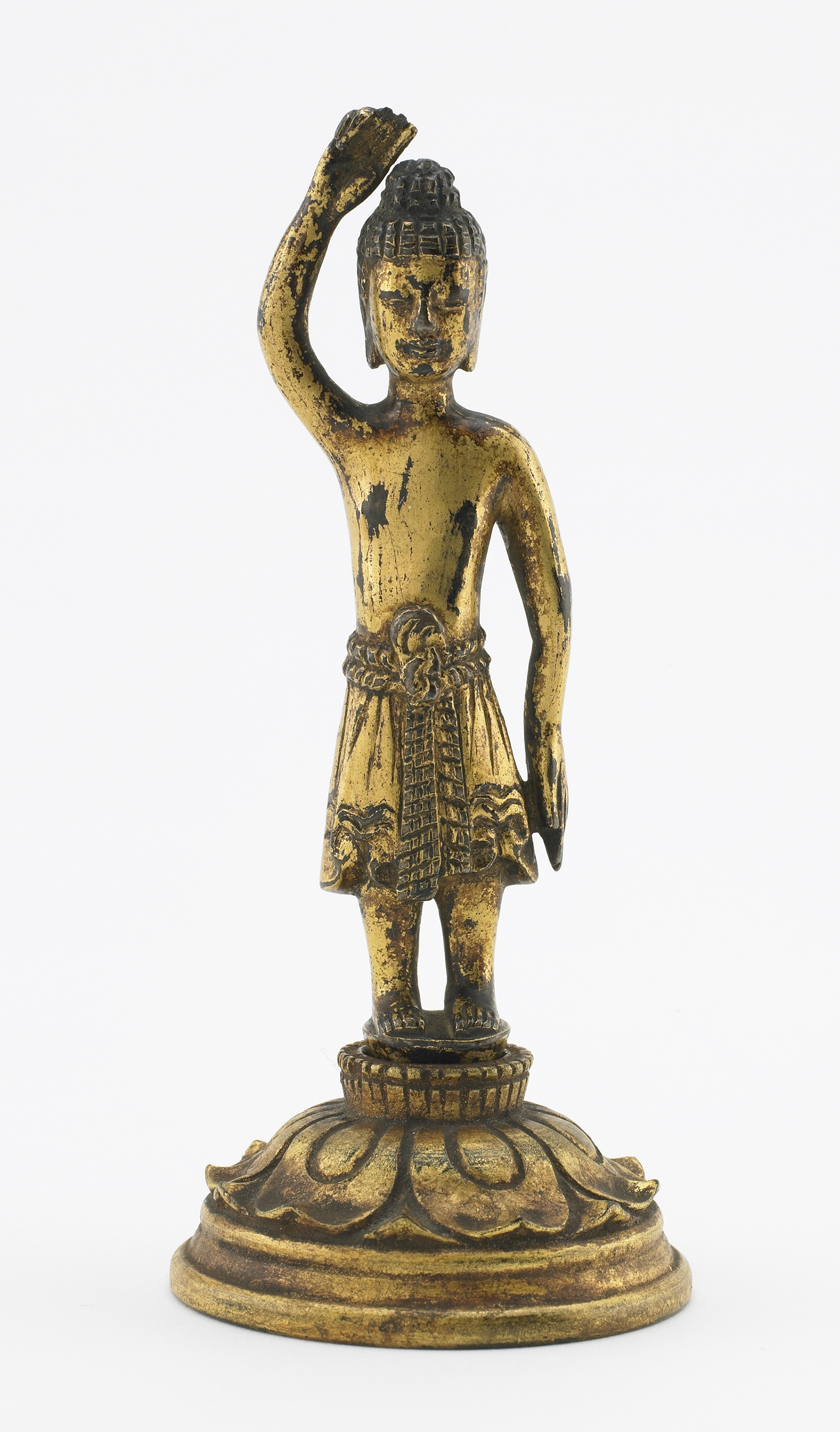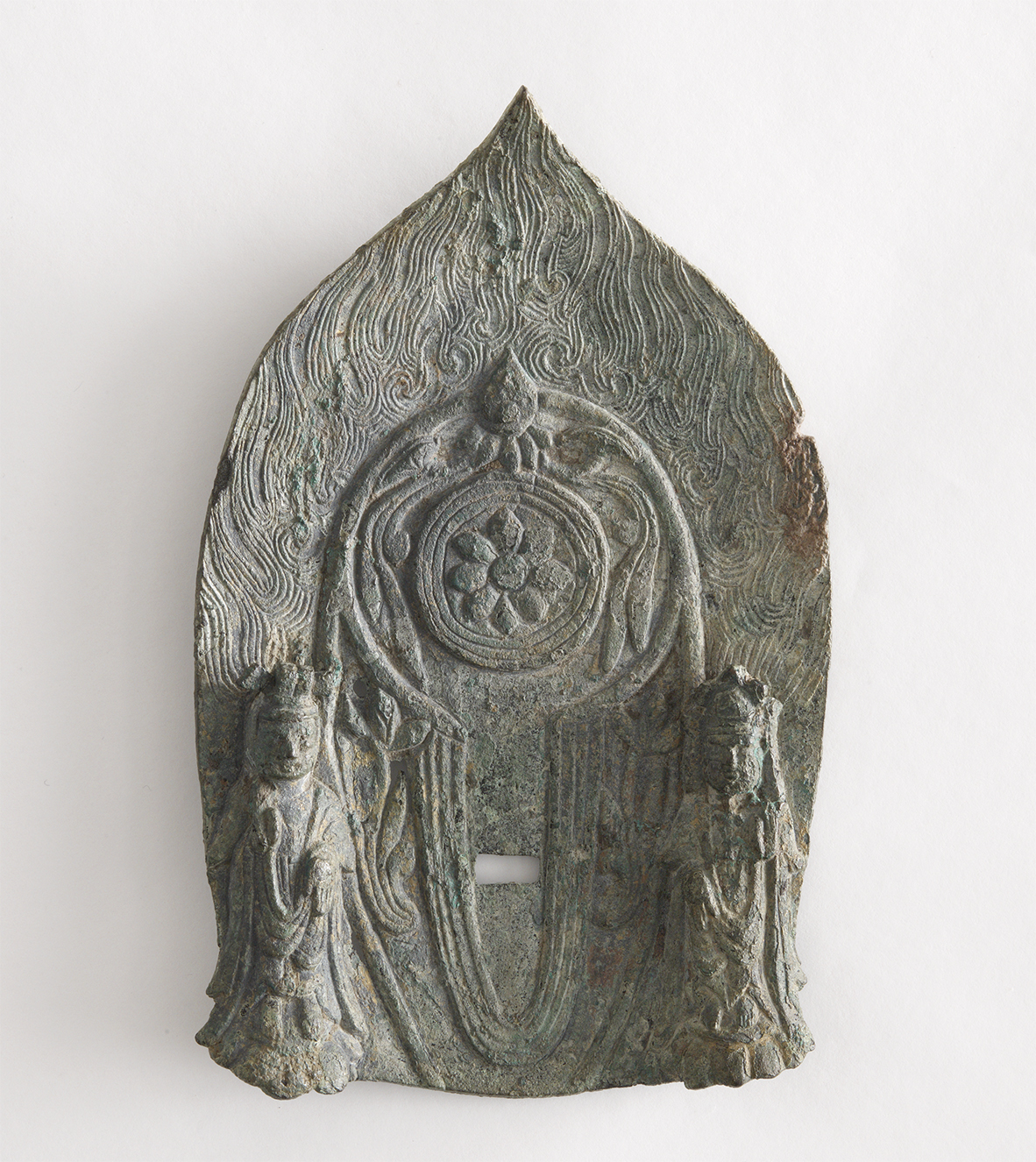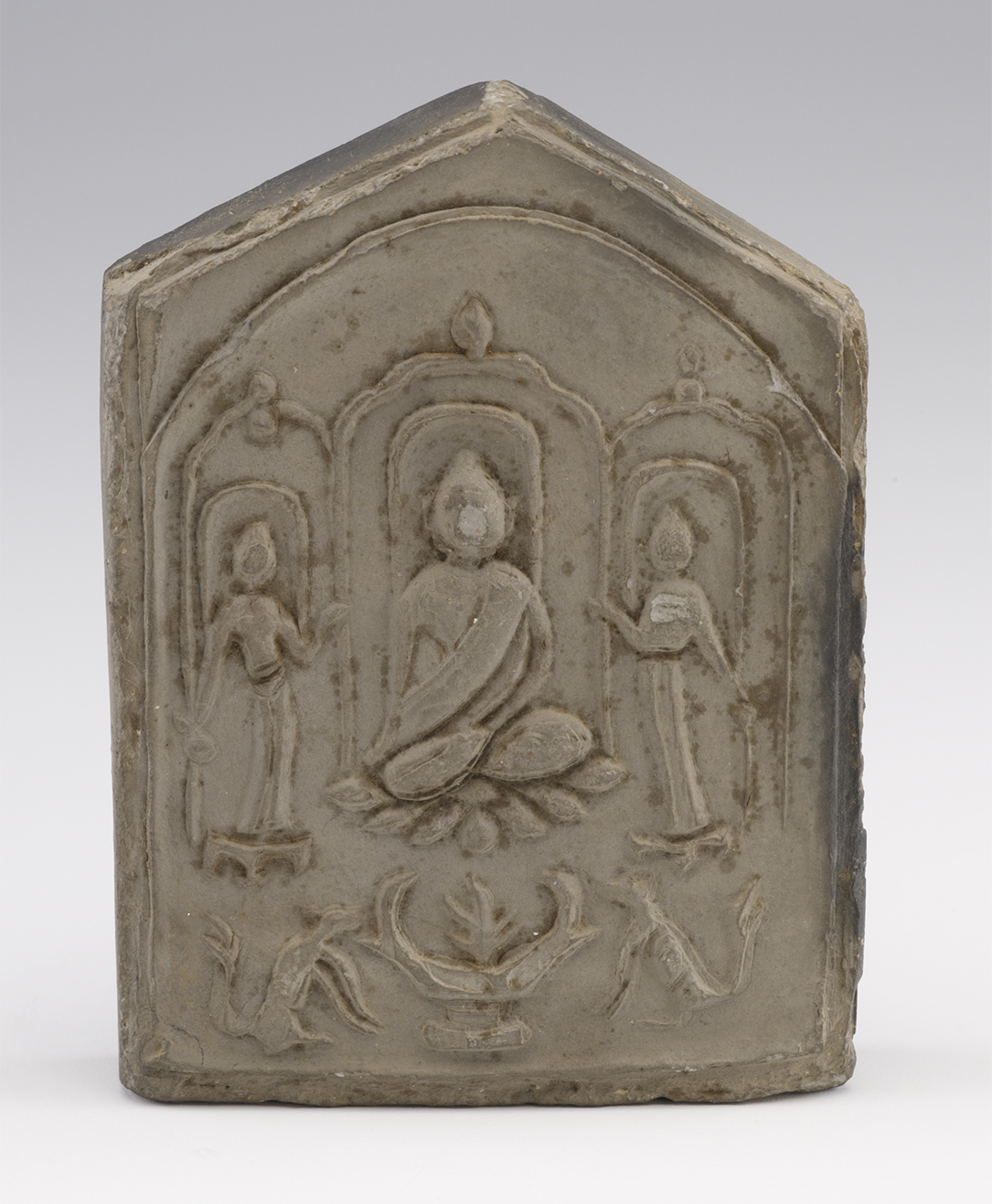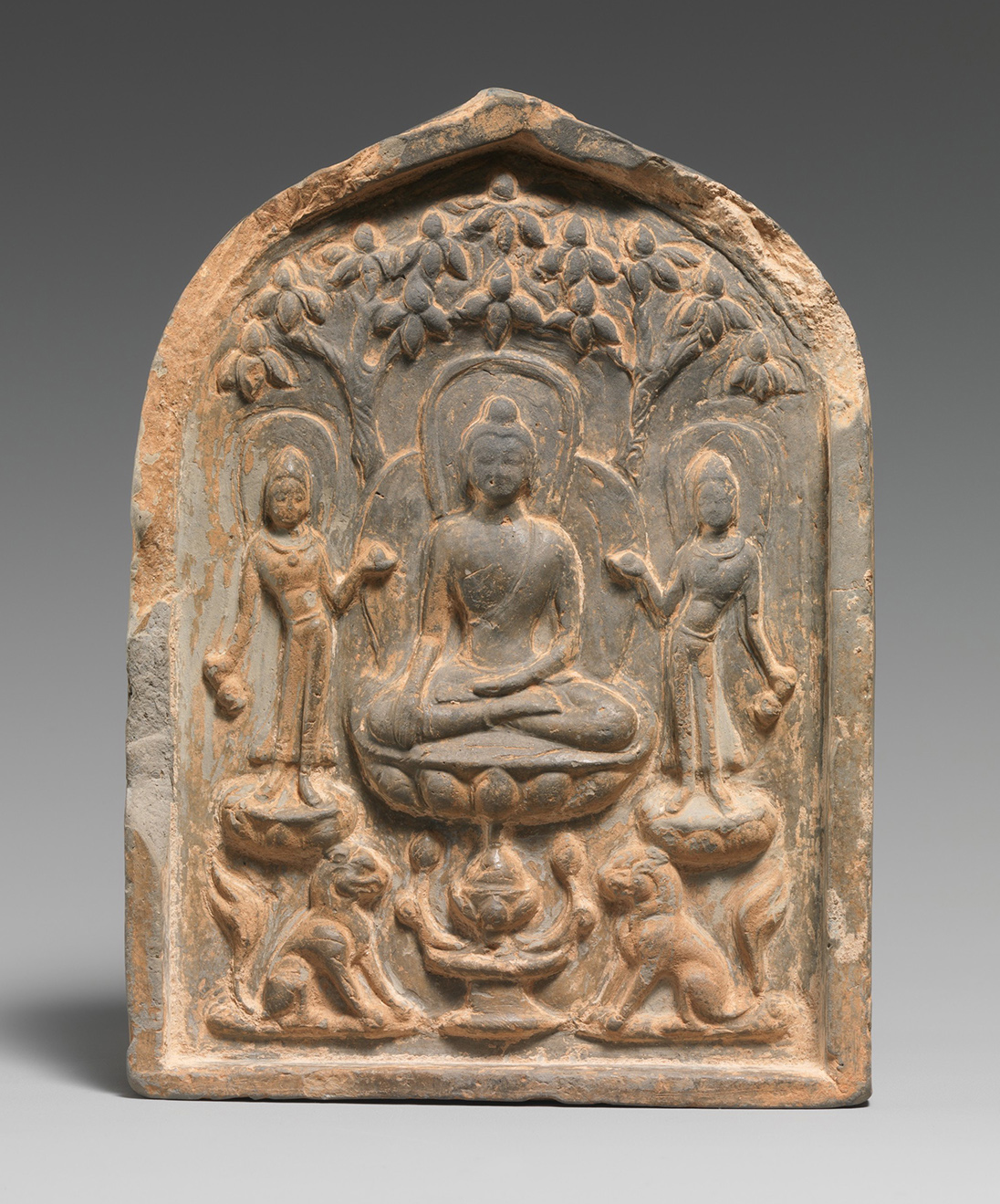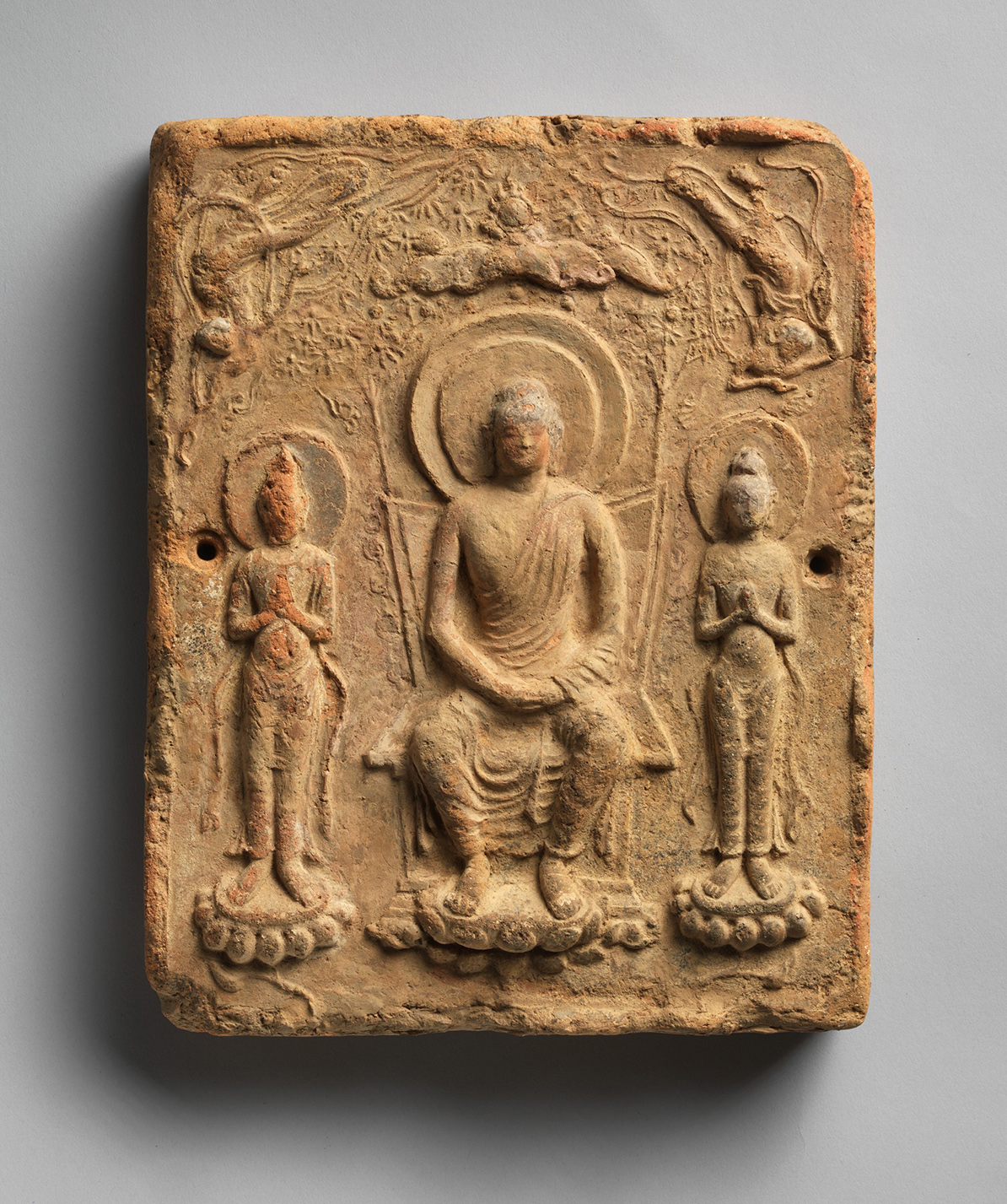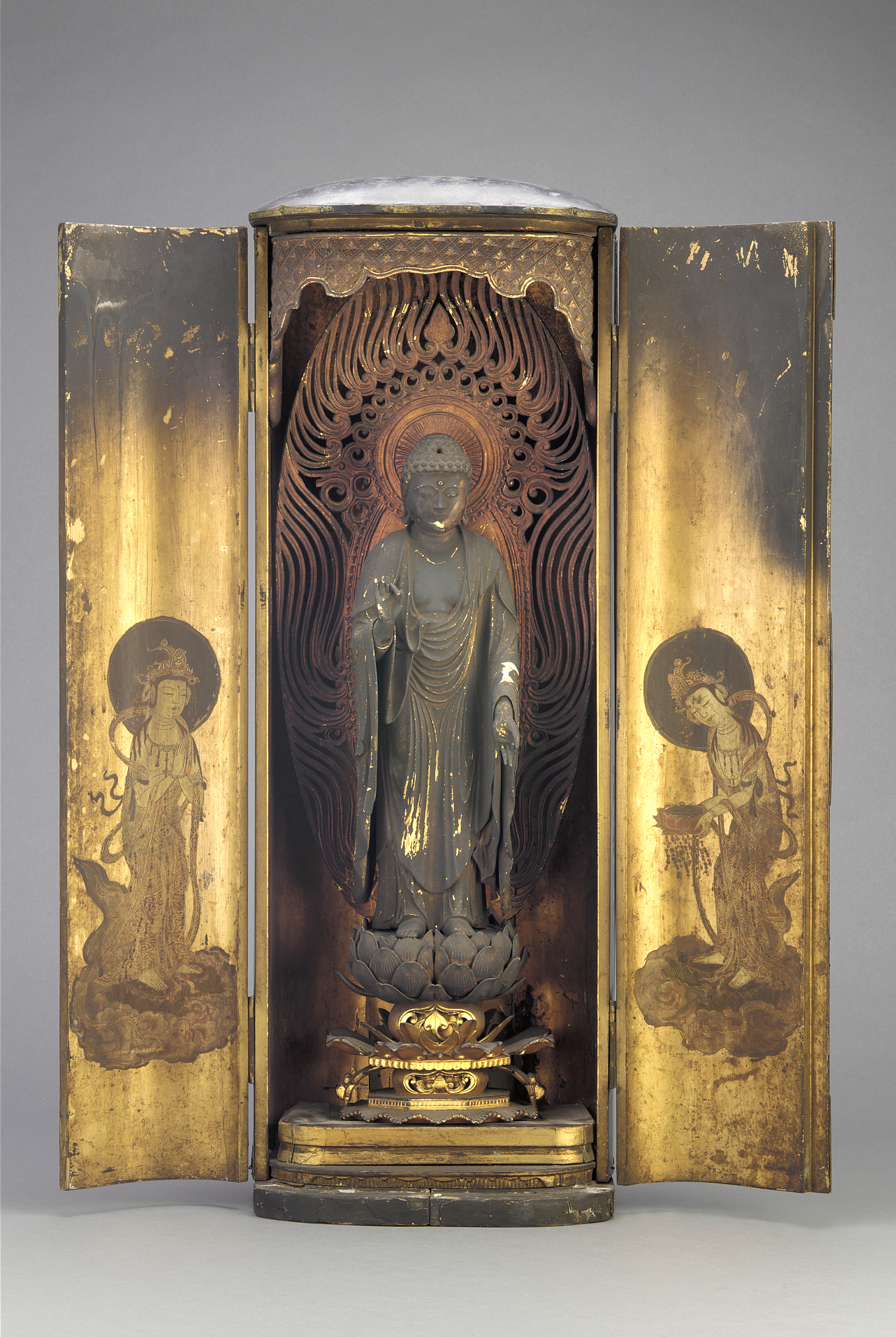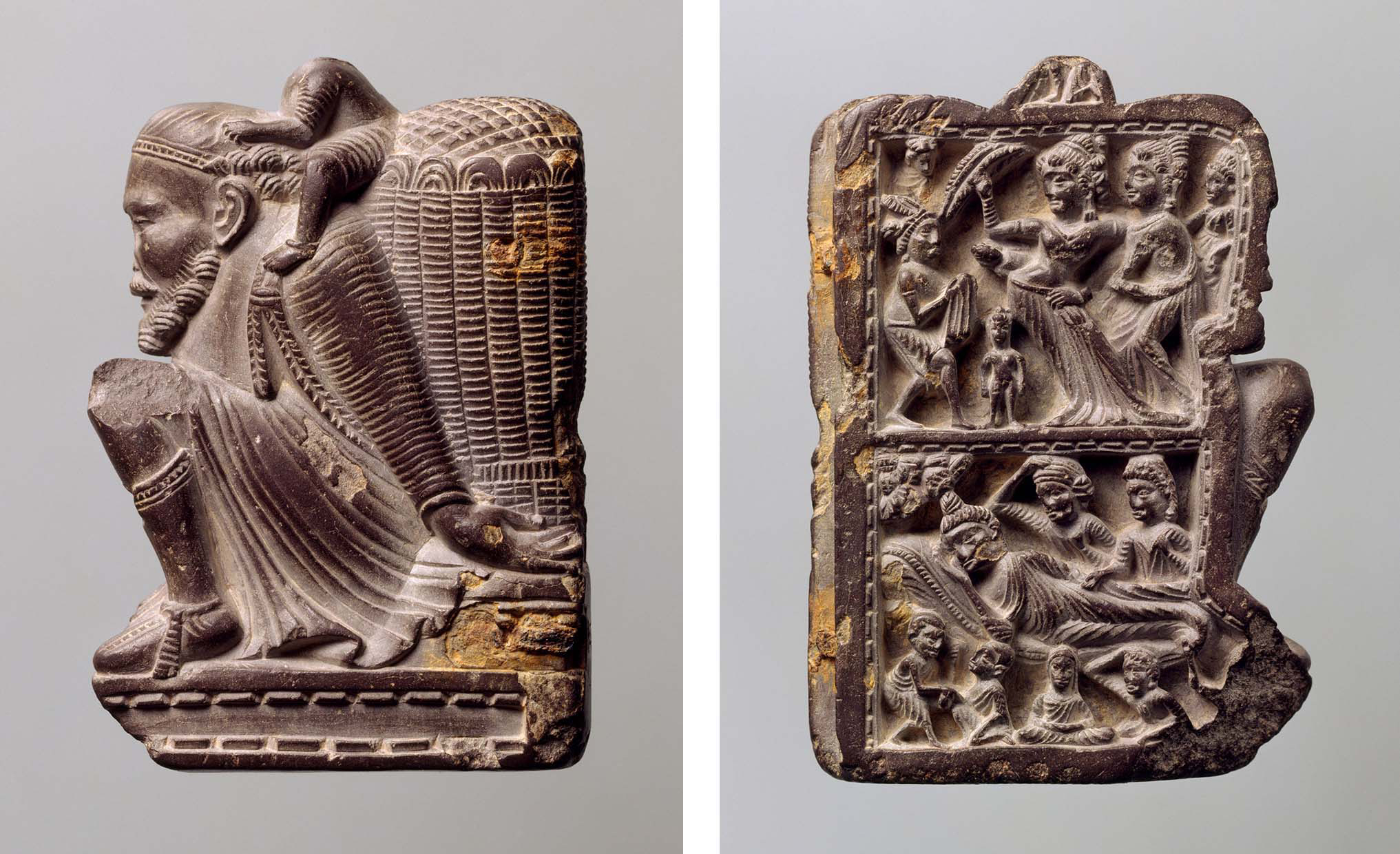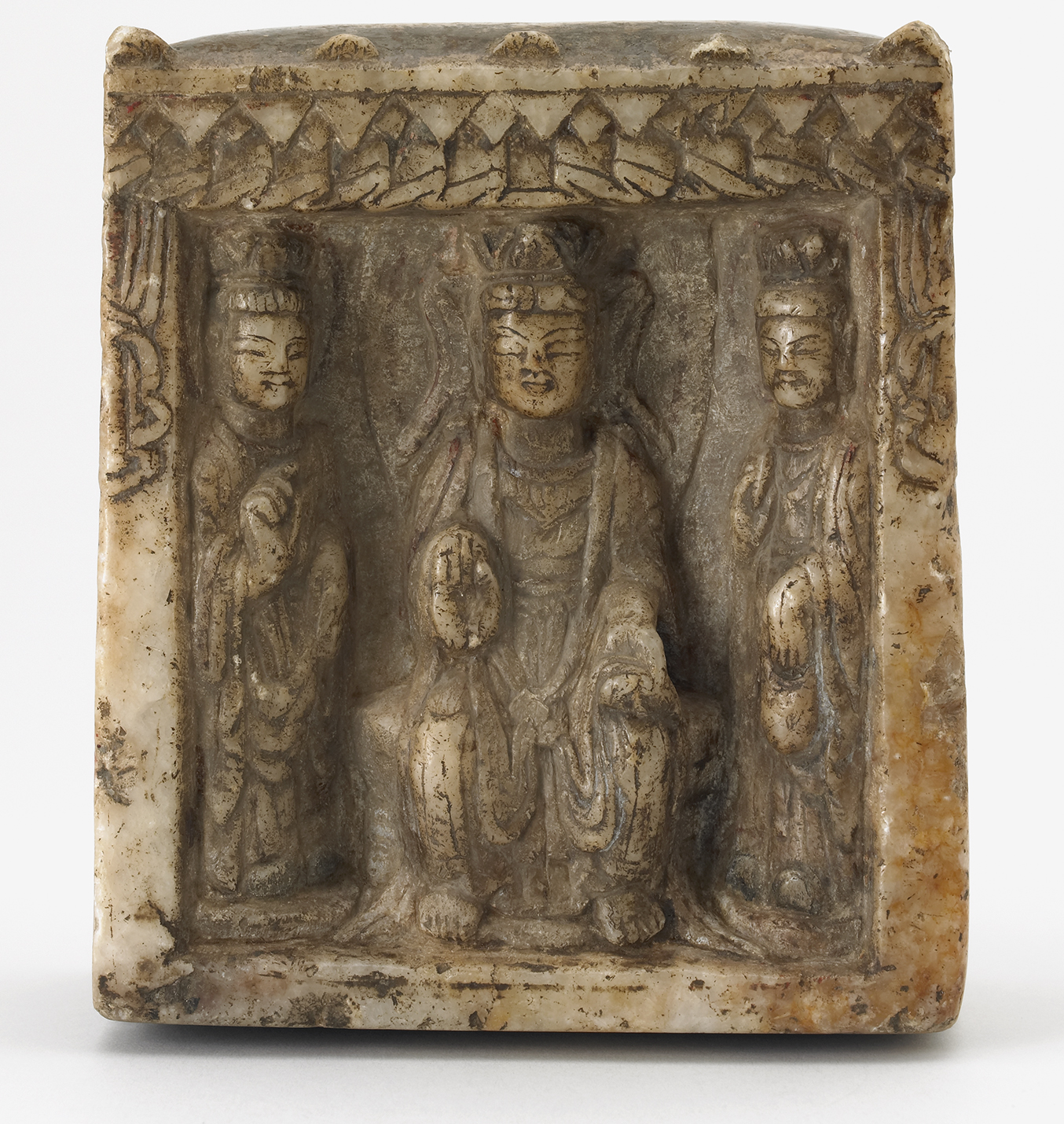According to the Nihon shoki 日本書紀 (Chronicles of Japan), Buddhism flourished in Japan during the Asuka period (ca. 538/552–645) when King Seong 聖王 (r. 523–554) of Baekje (18 BCE–660 CE) gifted Buddhist scriptures, canopies, and an icon of the Historical Buddha (Śākyamuni) to the Japanese court in 552.1 The episode highlights the intersection between Buddhism and diplomacy in the sixth century, but equally germane is the role played by portable icons in promulgating the religion across Asia. As Fabio Rambelli points out, portable artifacts abound in Buddhist material culture, and they effectively render the experience of the sacred palpable and transportable.2 While previous scholarship often attributes Buddhism’s ascendancy to its malleability in terms of political discourses or its appropriation of autochthonous belief systems, this article argues that it can equally well be explained by its broad array of portable artifacts that are adaptable to different religious situations. As Allen Grapard argues, territoriality is not the only way by which people can relate to a space religiously.3 The experience of the sacred can be mobile, momentary, or devoid of any geographical boundary. Likewise, portable Buddhist artifacts often uncouple religious experience from a fixed locale by effectively encapsulating the journey to Buddhist paradises or pilgrimage sites. In Japan, Buddhist objects such as miniature statues, mass-produced votive tablets, or portable shrines—which constitute the focus of this study—are as instructive as their monumental counterparts in revealing the modes of reception, social networks, and geographical reach of Buddhism in the archipelago. Their tenacity and ubiquity therefore pose the following questions: How should one approach the history of Buddhist art through the lens of movement and transportability? And to what extent does such history complement and complicate site-based scholarship that focuses on monasticism, geopiety, or hierotopy?
This article considers two factors as causing the relative lack of scholarship on portable Buddhist artifacts: the textual and the historiographic. Compared to icons in situ whose history can be inferred from texts such as inscriptions, temple records, or hagiographical accounts, the connection between portable artifacts and any temple or sacred space is often tangential, hence rendering them particularly unyielding to proper contextualization. Even for those icons that contain inscriptions, the text might be too generic, or contain names of obscure artisans and donors that cannot easily be mapped onto any known patronage network. At the same time, while Buddhist scriptures might shed light on the use and iconography of individual images, the exclusive use of this approach alone often falls short of addressing why certain miniature formats in Buddhist material culture remain efficacious across time.
The historiographic factor concerns what Bernard R. Faure calls the “modern aesthetic approach,” which presupposes Buddhist artifacts as “art objects” and their audience as disinterested connoisseurs.4 This approach not only suppresses the ritual dimensions of Buddhist objects, but it also dismisses sensory and emotional responses (such as enchantment or affection) that small-scale artifacts often elicit.5 Further amplifying this prejudice is the fact that most written sources associated with portable images in East Asia are not the canonical scriptures that preoccupy religious historians but non-ecclesiastic texts such as folktales and miraculous stories. As Rambelli observes, Buddhist practices, texts, and devotional objects that are not tied to a specific doctrine have long been dismissed as “impure” or “superstitious.”6 As a result of this bias, there remains a tendency to reduce small-scale Buddhist artifacts to merely amuletic devices for the masses. As demonstrated below, amuletic use constitutes only one facet of the many potential implications of these objects.
It should be stressed that it is not my intention to neatly classify Buddhist artifacts as either “portable/siteless” or “sedentary/site-specific.” It would be unproductive to fit every artifact into one or the other category—after all, miniature objects can be installed in an altar or a shrine for prolonged worship, and temples and monumental icons can be disassembled and relocated elsewhere. Furthermore, previous scholarship on cultic sites in Japan has compellingly demonstrated that even sacred spaces that are supposedly “fixed” (either geographically or territorially) are highly malleable. Consider, for instance, the discourse surrounding Kasuga as the manifestation of the Deer Park at Benares, where Śākyamuni conducted his first sermon.7 The main concern of this article, therefore, is less about creating a new classification schema than establishing a new lexicon and interpretive framework that facilitates a more precise description of extant works. “Non-site-specific” hence refers to an interpretive approach rather than a category in Buddhist art.
To this end, it is imperative to clarify my research scope and definition of certain terms. Portability refers to Buddhist artifacts that are designed primarily for ease of movement and tactile interaction.8 In other words, the formal properties of these works—including material, shape, scale, or even the gesture of the icon depicted—clearly indicate that they are designed with mobility in mind, and that they prompt the beholders to carry them around and interact with them on an intimate, sensuous level. While these objects can certainly be affixed to a site, their efficacy is only tangentially related to the space they are situated in; rather, their power is determined more by their interaction with the human body or the visual spectacle they orchestrate. In some cases, these objects are most efficacious precisely when they are perpetually “on the move,” adapting to a multitude of contexts across spaces and times. At stake, therefore, is not the creation of a neat binary between peripatetic and sedentary artifacts but the lacing of all forms of devotional practices, whether site-based or not, to the larger narrative of Buddhist material culture. To foreground the following argument, the material scope of this article is limited to Buddhist artifacts that are either handheld or transportable in both arms, and it draws heavily from the collections of the Smithsonian’s National Museum of Asian Art.9 Moreover, rather than constructing a genealogy of forms or styles, this study concerns the longevity of certain types of portable Buddhist artifacts in Japan that appear to have undergone neither a notable demise nor resurgence in popularity. Indeed, it is their very tenacity that demonstrates the significance of nomadic objects in Buddhist material culture at large.
Tactility and Intimacy: The Scalar Uses of Portable Icons
Our study begins with a gilt-bronze icon from Japan dated to the Asuka period (fig. 1; hereafter referred to as the Freer icon). What appears at first to be simple in subject and style turns out to be much more than that. The icon depicts a boyish figure with a masklike face and a columnar torso with minimal modeling. A subtle hint of emotion is suggested by the figure’s faint smile. His squat proportion, commonly deployed for Buddhist statues to highlight an icon’s visage and upper torso, accentuates his disproportionally long arms and large palms. Meanwhile, his lower body is wrapped in a simple loincloth that is accentuated with schematic, quivering lines that suggest drapery folds. The three-tiered pedestal consists of a bucket-like stand that sits atop a lotus blossom over a circular base. Despite its diminutive size, the icon commands attention via its strong frontality, pronounced gesture, and inviting facial expression. Here, the unknown sculptor navigated a fine balance between representing a dignified saint and a precocious child, a presence that is otherworldly yet humanely relatable.
The style of the Freer icon is representative of the so-called boyish-face (dōgan 童顔) or boyish-form (dōgyō 童形) icons in East Asia that are dated around the seventh century. They are characterized by their youthful visage, large head, narrow shoulders, and squat bodily proportions.10 With subtle variations among individual pieces, extant works in this subset share a certain stylistic consistency, leading scholars such as Donald F. McCallum to argue that the same artisanal group was involved with their production.11 In terms of iconography, the image unmistakably represents the Historical Buddha at birth (tanjōbutsu 誕生仏). As recounted in the Guoqu xianzai yinguo jing 過去現在因果經 (Sūtra of past and present cause and effect), as soon as Śākyamuni was born, he took seven steps, raised his right arm and lowered the left, and declared himself the master of heaven and earth.12 The Freer icon, however, represents the Buddha as a young boy (with the premature insertion of the snail-shell-curl hair) rather than a newborn. While such representation was not unique to Japan, the seemingly unassuming image in fact performs the delicate task of balancing both narrative clarity (the Buddha as an infant) and ontological accuracy (the Buddha as a transcendental being).
The inspiration for early Buddhist icons in Japan remains a matter of speculation. While images of the Northern Qi (550–577) or Northern Zhou (557–581) are often cited as the plausible prototypes, Huh Hyeong Uk and Denise Patry Leidy consider works from the Korean peninsula as exerting more direct impact on the archipelago.13 In fact, diplomatic missions across the East Sea did intensify during the Asuka period when different Korean kingdoms sought to establish alliance with Japan to counter the threat of one another. As the previously cited episode in 552 from the Nihon shoki indicates, portable Buddhist images were indeed mobilized as diplomatic gifts, and they might have inspired the production of Buddhist icons in Japan. One such example is a sixth-century aureole from the Korean peninsula (fig. 2). Although the central image is missing, the aureole’s flaming pattern strongly resembles that of the Śākyamuni triad at Hōryūji. The flanking bodhisattvas of both works also share similar body proportions and drapery patterns. Indeed, the use of miniature Buddhist icons as the models for life-size or monumental images can be inferred from an entry in the Nihon shoki, which records that in the year 606 the female ruler Suiko 推古 (r. 592–628), upon the successful installation of the main icon at Asukadera, praised the artisanal family involved for producing a scaled model of Buddhist icons to her satisfaction.14
To reduce portable icons to mere “models” for bigger images, however, would be a gross simplification. Returning to the diplomatic event of 552, it was apparent that this gifting was concerned with spreading the faith as much as linking political and religious authorities. Such coupling was nothing new by the sixth century; one can trace its origin to the legends of the Mauryan King Aśoka (r. ca. 268–232 BCE), whose political mandate was consolidated by his extensive Buddhist patronage. When translated into the East Asian context, the Buddhist ideal of rulership, which stresses compassion and benevolence as the indispensable qualities of a great sovereign, was readily mapped onto the Confucian notion of the Mandate of Heaven (tianming 天命).15 Hence, as a diplomatic gesture, the gifting of Buddhist images symbolized the conferral or recognition of power from one political entity to another. In particular, the gesture was intended to position the receiving party within the lineage of sagacious rulers who were destined to disseminate the Dharma and whose political mandates were indisputably sanctioned by a higher authority.
In early Japan, such negotiation was most notable in the refashioning of political figures such as Prince Shōtoku 聖徳太子 (574–ca. 622) as the Dharma Ruler (hōō 法王), the material trace of which has been thoroughly analyzed by Akiko Walley with reference to icon inscriptions and hagiographical texts related to Hōryūji.16 As Torquil Duthie argues, amid continuous machinations by royal members and rivalries among kinships groups, the political foundation of the Japanese court during the sixth century was precarious at best.17 Against such a backdrop, Buddhism offered the much-needed discursive framework to consolidate the court’s authority and justify its centralization measures across the archipelago. To qualm doubts about and resistance to importing the foreign religion, the court also faced the urgency to substantiate the claim that Japan was the country destined to preserve and promulgate the Dharma. Miraculous accounts designed for such purpose soon followed. To name just a few examples, in 584 the relics of the Buddha were discovered in a rice bowl by the politician Soga no Umako 蘇我馬子 (d. 626) during a temple ceremony; in 595 a log of sandalwood—the material allegedly used for making the first image of the Buddha—was found floating ashore on Awaji Island.18
However, the use of portable icons as diplomatic gifts or artisanal models cannot satisfactorily explain the proliferation of Buddha-at-birth images in early Japan. On the one hand, the image of Śākyamuni meditating or as a preacher would be much more suitable at diplomatic occasions. On the other hand, nearly all extant Buddha-at-birth icons are miniature rather than life-size images.19 As such, the popularity of Buddha-at-birth images demands an alternative framework of analysis, one that pays close attention to how their formal qualities— particularly their very handheld-ness—interact with the human body and prompt a certain response or action. With regard to the Freer icon (fig. 1), it is noteworthy that the unknown artisan not only elongated but also bent the image’s right arm. The representation appears quite common for tanjōbutsu in this period; other contemporaneous works with similar sizes and features have been found in the collections of temples such as Shōgenji, Shōfukuji, and Kasagidera, suggesting that it was a conscious stylistic choice to entice haptic interaction.20 This is so particularly with regard to the fact that the curve formed by the contorted arm would have neatly fit into the ridges of one’s palm or the gulf between one’s thumb and index finger. The Freer icon therefore sheds light on an alternative mode of icon engagement in Buddhism that is predicated on tactility and intimacy. Such a mode of interaction significantly departs from the kind of frontality and visual hierarchy orchestrated in a temple setting, in which beholders stand or kneel from a distance and gaze up at the statue installed above a pedestal. By contrast, the Freer icon is designed to be carried and interacted with; its maker further conjured a sense of intimacy by endowing the infant Buddha with a subtle, enigmatic smile.
This haptic mode of interaction raises a key question: what role does scale play in Buddhist art? As Joan Kee and Emanuele Lugli poignantly argue, scale can be understood as “the relationship between the actual physical magnitude of a thing and the way that magnitude is represented.”21 Scale and its manipulation can effectively displace us and transform how one relates to the world at large. Miniature objects such as the Freer icon are mesmerizing in that they compel us to gaze and interact with them closely and at length. Their unfathomable interiority lures us into what Gaston Bachelard calls the realm of “intimate immensity” that suspends any normative understanding of space and time.22
Concurrently, this state of enthrallment establishes a symbiotic relationship between the miniature artifacts and their owners. In the case of the Freer icon, just as the image is dependent on a human agent to serve as its vehicle of movement, so does the human agent rely on the icon as a portal to gain an expedited, intimate access to the divine. The entanglement between miniature icons and their users is perhaps best understood through some parallels, inexact but suggestive, in early Buddhist miraculous tales in East Asia. For instance, the Mingxiangji 冥祥記 (Signs from the unseen realm) by Wang Yan 王琰 (ca. 454–ca. after 502) contains an account of “numinous verification” (lingyan 靈驗) that revolves around an army general named Nangong Ziao 南公子敖 (dates unknown) during the Jin dynasty (266–420). Held captive by his enemy, Ziao anticipated his execution and concentrated his mind on the Bodhisattva Guanshiyin (Avalokiteśvara). Miracles soon came to pass: the executioner lost his strength, and the blades either fell to the ground or self-disintegrated. Ziao was subsequently pardoned and managed to escape. He then made a small image of Guanshiyin, enshrined it in a box made of fragrant wood, and wore it above his head wherever he went.23 The story of divine intervention that extricates the faithful from danger is a recurring trope in Buddhist miraculous tales. What concerns us here is Ziao’s ways of engaging the icon. Instead of embellishing it above a pedestal in a monastic setting, the protagonist wore the icon to express his gratitude to the deity. Here is an image whose meaning is completed only when it interacts with both its owner’s body and the trajectory of his life. The story of Ziao indicates a mode of icon engagement that is much more intimate, sensuous, and durational than that offered in a monastic setting.
Similar stories revolving around portable icons can be found in the Nihon ryōiki 日本霊異 記 (Record of the miraculous and strange in Japan) compiled by Kyōkai 景戒 (dates unknown) between 787 and 824. One such account concerns Ochi no Atae 越智直 (dates unknown), an ancestor of the governor of Ochi district in Iyo province who was captured during an expeditionary mission to Baekje in the seventh century.24 Imprisoned on an island, he and other captives acquired an image of Avalokiteśvara and installed it over a boat that they built. As a sympathetic response to their faith, the icon safeguarded their escape and dire journey across the East Sea.
That miniature icons are also referred to as jibutsu 持仏 (“handheld icon”) or nenjibutsu 念 持仏 (“handheld icon for recitation”) in medieval Japan further indicates the importance of the tactile experiences involved with their uses.25 For the latter term, it should be noted that nen 念 is a polyvalent word. Apart from its literal meaning (“to recite” or “to recollect”), nen is also the shorthand for the practice of mindfulness (anusmṛti) that requires Buddhist practitioners to concentrate wholeheartedly on an image, a vow, or the act of breathing.26 Hence, depending on the context, nenjibutsu can be understood as “an icon held in one’s mind”; one can easily imagine how each owner of the Freer icon would grip it to their chest and chant their prayers single-mindedly. Indeed, signs of wear and tear commonly found in miniature statues, notably the sides and back of both arms of the Freer icon, are indexical of the tactile interaction involved. Especially for miniature icons that are passed down through generations, these marks constitute what Jessica Hughes calls the “sensory memory” that accentuates the image’s perceived efficacy.27 While in-situ, monumental icons often interact with practitioners in an occasional, ritual-specific manner, miniature icons operate durationally in that they follow and perform in accordance with the life trajectory of their owners. In this sense, portable icons strongly resonate with Hans Belting’s argument that images exist not merely as objects but as events that happened.28 Once activated, their potentials are fully realized only when they have a lifespan in tandem with that of their owners.
Situational Icons: Senbutsu and the Limit of State Buddhism
The case of the Freer icon foregrounds the roles that scale and tactility play in conjuring religious experience. Yet, the aim of this study is not merely a call for closer formal analysis. In fact, the case of portable artifacts also has the potential to complicate if not challenge certain perceived notions about early Buddhist development in Japan. Consider, for instance, the Tang-dynasty (618–907) figural clay plaque (tuomo nixiang 拓模泥像 or shanye nixiang 善業泥像; Japanese: senbutsu 磚仏) in the Freer collection (fig. 3; hereafter referred to as the Freer plaque). In lieu of the conventional round halo, a screen-like structure stands behind the central buddha and two flanking bodhisattvas. Based on the Buddha’s distinctive earth-touching gesture (bhūmisparśa mudrā), the image unmistakably represents the famous Mahābodhi temple image associated with the pilgrimage site of Bodhgayā in India. According to the pilgrim-monk Xuanzang 玄奘 (602–664), a Brahman agreed to create an image of the Buddha on the condition that the temple doors be sealed for six months so that he could concentrate without interruption.29 Curious about the progress, members of the congregation opened the doors after four months, discovering an unfinished image of a seated Śākyamuni in the earth-touching gesture. Later, the Brahman appeared in a devotee’s dream and revealed his true identity as Maitreya, the future Buddha. Recognizing the image as a divine miracle, the congregation embellished it with a necklace of precious stones and a crown of exquisite gems.
As the product of divine intervention, the Mahābodhi temple image was considered authentic in the sense that it could stand for the true body of the Buddha, a quality that was transferable to its copies.30 Often labeled “true visage [of the Buddha]” (zhengrong 眞容) or “auspicious image” (ruixiang 瑞像), this particular icon was replicated in all shapes and materials in major Buddhist sites across Asia.31 Its development is confirmed by an earthenware image excavated from Shaanxi province that shares with the Freer plaque a tripartite composition and the same hand gesture of the central Buddha (fig. 4). The additional canopy formed by a bodhi tree further aggrandizes the triad’s regal presence. That the issue of authenticity is central to the efficacy of such an image is evident in the inscription on its back: “Great Tang good karma clay pressed to obtain a True [Image] like the marvelous physical body [of the Buddha] (Da Tang shanyeni yade zhenru miaoseshen 大唐善業泥壓得真如妙色身).”32 The production of Buddhist figural tiles with the same inscription most likely began when Xuanzang resided at Daci’ensi between 648 and 658 after his journey to India.33 Portable and cost-effective, icons produced using this method began to appear in Japan in the 660s when the court sponsored multiple temple projects across the Nara basin.34
What most concerns this study is the multivalence of figural clay images. According to Yoko Hsueh Shirai’s exhaustive research, besides the obvious devotional use, this image type served a wide range of purposes across East Asia.35 First, they were produced by monks daily as part of their meditation rituals. Second, they were acquired by pilgrims as souvenirs from their visits to sacred sites. Third, given that they are found in or near Buddhist monuments and sacred spaces, it is believed that devotees who made or patronized these images did so to generate merit. Fourth, figural clay images were also used as tiles to embellish the walls of temple structures such as image halls and pagodas. This last function is proven by the reverse sides of figural clay images in Japan, which often contain equidistant holes or deep grooves for securing the images to a wall surface.36
As Shirai argues, the architectural use of figural clay images engendered considerable modifications in their shape and iconography in early Japan. Compare, for instance, the Freer plaque and the seventh-century senbutsu from the Mary Griggs Burke Collection at the Metropolitan Museum of Art (fig. 5). Most notably, the pointed top is foresaken to form a full rectangle in order to ease the stacking of senbutsu on a wall. The enthroned Buddha is shown with both legs pendant and feet resting over a lotus pedestal, his palms turned up to form the meditative pose (dhyāna mudrā). The additional upper corners are embellished with a pair of flying celestial figures; below them two bodhisattvas with almond-shaped halos press their palms to form the prayer pose (añjali mudrā). Unlike the Mahābodhi temple image (see figs. 3, 4) that unmistakably represents Śākyamuni, the iconography here appears ambiguous as the absence of any attribute on the bodhisattvas’ crowns renders it difficult to ascertain whether the central figure represents Śākyamuni or Maitreya. As Shirai notes, it is plausible that the iconography of some senbutsu might have been left intentionally ambiguous so that they could easily be adapted to different contexts in early Japan.37 Shirai’s proposition is further supported by senbutsu discovered in sites such as Kawaradera; despite sharing the same Buddhist triad, the tiles were inscribed on the reverse with the names of Śākyamuni, Maitreya, or Amitābha, the Buddha of the Western Pure Land.38 The practice indicates that iconographic ambiguity might have governed the design of certain senbutsu so that, depending on the context of use, their patrons, makers, or worshippers could project the deities they wanted to see onto the images. Given that the field of Buddhist art often preoccupies itself with iconographic certainty, Shirai’s observation is productive in that it urges us to consider the fixity of identity not as a predicament but rather as an option for how devotional images might have operated in premodern times.39
In light of their functional and iconographic fluidity, senbutsu in Japan exemplify what I call “situational icons”—images whose devotional use constitutes only one facet of their multivalence. Adaptable to multiple contexts, senbutsu could be installed on an altar for worship or affixed to the wall of a temple structure for embellishment. What is more, with their low cost and ease of replication, senbutsu were the ideal medium for producing Buddhist images en masse to meet the growing demand for icons in early Japanese Buddhism. This was especially the case for areas or communities who could not afford the commission of temples or metal images. Functioning outside monastic settings, these senbutsu were most likely installed in the residence of regional governors, communal spaces, or rudimentary worship halls that did not have proper temple facilities or clerics in residence. Primary sources further support this possibility. According to the Nihon shoki, Emperor Tenmu 天武 (r. 673–686) issued an edict in 685 ordering that every house (ie goto 家毎) in all the provinces install a Buddhist shrine (bussha 仏舎), and that worship and offerings of food should be made to it.40 Given that in this period the court had yet to fully centralize its power, and that the development of Buddhism remained largely clan based, McCallum argues that ie goto should be understood as the households of powerful regional families rather than of provincial governors, and that bussha did not refer to state-sponsored temples but rather to small worship halls or even portable shrines installed in these private residences.41 His observation is supported by the intersection between family-based and state-level Buddhism in the Asuka period; as Lori Meeks points out, a majority of “state temples” in early Japan started off as private, small-scale worship spaces in the mansions of court members or powerful clan families.42
Tracing the uses and distribution of senbutsu thereby sheds light on the uneven development of Buddhism in early Japan. This, in turn, casts doubt on the framework of “state Buddhism” (kokka Bukkyō 国家仏教), which presumes that the Japanese court took the center stage in promulgating Buddhism to suit its political needs. Within this framework, the spread of Buddhism became largely a function of political centralization, and both processes were by default top down and unidirectional; the religious-political agendas instated by the court were diffused through a bureaucratic structure that extended from the capital to the provinces. Such an approach, however, has increasingly come under scrutiny. Bryan D. Lowe, in particular, argues that “state Buddhism” was a myth conjured by historians, and that even by the Nara period (710–794)—a time when said centralization projects were supposedly a fait accompli—the image of a full-fledged state-monitored bureaucratic network as presented in court documents often ran contrary to that recorded in other sources.43 That multiple court edicts detailed the formation of a state-wide Buddhist institutional network did not necessarily mean that any uniformity was achieved among temples in provincial areas. As Lowe points out, the reverse was equally true; the building of Buddhist facilities in the capital and nationwide transportation networks actually hastened the drain of ritual specialists and resources in provincial areas.44 The image of a perfectly systematized Buddhist bureaucratic state was thereby an ideal conjured by primary sources and modern historians. With reference to the Nihon
ryōiki, Lowe also calls attention to the recurring themes of self-ordained clerics (shidosō 私度 僧), itinerant monks or nuns, makeshift rituals conducted in domestic spaces, and dilapidated temples in peripheral areas.45 Such contexts might explain the discovery of senbutsu in sites without established Buddhist infrastructures. Portable, replicable, and cost-efficient, senbutsu would suit the lifestyle of wandering clerics and meet the needs of provincial communities that lacked the means to commission temple or metal icons. The case of senbutsu thereby foregrounds not only the fluidity of the uses and meanings of portable images, but also the urgency to think beyond a center-periphery approach in understanding the complexity of Buddhist development in early Japan.
Unveiling the Sacred: The Kinaesthetics of the Portable Shrine
Ubiquitous among most museum collections, portable shrines from Japan remain one of the most conspicuous yet less well-studied types of Buddhist artifacts. Their enduring popularity compels us to consider how kinaesthetics—here defined as the sensory experience one derives from the interactive elements of miniature artifacts—conditions the perception of the divine.46 One such shrine from the Freer collection (fig. 6; hereafter referred to as the Freer shrine) encases a wooden Buddha that is paired with two painted bodhisattvas in the interior. Traces of frequent use are evident at the inner top section of the movable wings where incense smoke darkened the gilt ground. Based on the attributes on the bodhisattvas’ crowns, the triad represents a standing Amitābha flanked by Avalokiteśvara on his left and Mahāsthāmaprāpta on his right. Their inviting gestures suggest the shrine’s possible use in deathbed rituals in which the deities would descend upon the calling of the devotees and guide the deceased to the Western Pure Land.47
Even today, the practice of encasing icons or sacred texts in a portable shrine (zushi 厨子) remains common among Japanese households.48 The enduring popularity of zushi indicates an overlooked yet highly pervasive mode of religious dissemination in Japan, one that is informed, but not determined, by institutionalized Buddhism. The varying sizes, shapes, and iconographies of zushi further suggest a workshop-style production that is modular yet flexible enough to meet the specific needs of respective patrons. While previous scholarship on Buddhist image makers (busshi 仏師) focuses primarily on elite patronage (such as Tori Busshi 止利仏師 in the Asuka period, the In 院 School and the Heian court, or the Kei 慶 School and the Kamakura shogunate), the case of portable shrines indicates an alternative pattern of patronage that appealed to devotees across a much wider social spectrum. The quantity and diversity of extant zushi suggest that, besides large-scale sculptural programs for affluent temple networks, the production of portable shrines would have provided a stable source of income for workshop-based busshi in medieval times.
By the fifth century, portable shrines had already been popular among Buddhist devotees in the region of Gandhāra. One such example, which is half of a diptych-shaped shrine, represents a donor figure in squatting position on its exterior and juxtaposes scenes of the Buddha’s miraculous birth and his parinirvāṇa on its interior (fig. 7).49 While this example confirms the popularity of small-scale shrines in the early stages of Buddhist diffusion, it remains difficult to establish any stylistic genealogy of Buddhist portable shrines from Gandhāra to Japan over time. This is especially the case given the scarcity of surviving examples dated before the Freer shrine in China and Korea, and even in Japan the majority of extant zushi are dated to or after the late medieval period. Such large material-historical gaps render it difficult to substantiate any teleological account of the formal or stylistic development of Buddhist portable shrines across Asia.
An exquisite example from Tang-dynasty China (now in the collection of Kongōbuji), however, indicates a shift by the eighth century in which the narrative-centric representation gave way to an immersion-centric one that dramatizes the presence of Buddhist deities in front of their beholders. As a prime example of a sandalwood shrine (known as dangan 檀龕 in Japanese), this work is believed to have been imported from China to Japan by the monk Kūkai 空海 (774–835), and it depicts Śākyamuni at the center flanked by two bodhisattvas on the side wings, each with their own group of accompanying figures.50 Despite iconographic differences, the Kongōbuji shrine and the Freer shrine are compositionally similar in that they share a tripartite structure with moveable wings, interiors compartmentalized by individual deities rather than narrative sequences, and, more importantly, main icons who turn frontally toward the viewers. The Kongōbuji shrine hence indicates that by the eighth century, the immersion-centric mode had outweighed narrative-centric representation in the production of portable shrines in East Asia.
At the same time, the etymology of zushi suggests that the form of portable shrines in Japan might take cues from the kind of cabinets (chu 廚 or chuzi 廚子, with which zushi shares the same sinographs) in early medieval China that preserved or enshrined religious artifacts.51 One of the earliest texts that mention these devices is the sixth-century Yu Sengzheng jiao 與僧正教 (A letter to the chief abbot), in which the author Xiao Gang 蕭綱 (503–551) notes that in Yongzhou, one often finds cabinets (chu) housing different icons for worship.52 Meanwhile, the fifth-century Daoist text Zhen’gao 真誥 (Declarations of the True Ones) details that the Daoist master Xu Cheng 許丞 (dates unknown) deposited scripture inside a portable cabinet (chuzi) when he fled from the political turmoil in 429.53 Both records indicate that the use of chu or chuzi was not exclusively Buddhist, and that the device might operate as an eclectic religious space that accommodated a wide range of icons and cultic practices in early medieval China.
To understand the enduring popularity of zushi in Japan, one may approach it less as a storage device than as a visual strategy designed to orchestrate an intimate encounter with the sacred, taking cues from Michelle C. Wang and Lin Wei-Cheng’s incisive discussion of the performative quality of Buddhist art, which they define as the kind of “visual and material properties” that have the capability to “both engage with as well as be engaged by devotees in a transformative manner.”54 Put differently, Wang and Lin challenge the supposed subject/object binary in the study of religious art by redistributing agency from the beholders to the Buddhist artifacts. Rather than being passively acted upon, Buddhist icons or architectural spaces are often designed not only to be interacted with but also to orchestrate how viewers would gaze, act, or behave.
In the case of portable shrines, their performativity is both formally and conceptually connected to two modes of icon enshrinement in continental Buddhism: alcoves in Buddhist caves and miniature votive tablets that often assume cavernous or architectural form. With regard to the former, it was common for early Buddhist caves in China to compartmentalize their walls and central pillars into a cluster of alcoves (gan 龕) for individual Buddhist icons in stand-alone or triad form. In some cases, the names and wishes of respective donors or groups of acquaintances (shan zhishi 善知識) are inscribed at the bottom, suggesting that these alcoves might have served as vehicles of fundraising for monastic communities at these sites.55
The popularity of alcoves in Buddhist caves, in turn, might have inspired the design of freestanding, portable votive tablets made from stone, wood, or ivory. One such example from the Freer collection is a handheld marble tablet that represents Śākyamuni and Maitreya triads on its wider sides, and a standing bodhisattva on each of its narrower sections (fig. 8). The design strongly recalls the central pillar of a Buddhist cave that is embellished on all sides for circumambulation. Upon closer inspection, rolled-up curtains—a feature that also appears in the Freer shrine—are inserted on all facets to dramatize the moment of sacred encounter, as if the icons have just manifested themselves in front of the beholders. Indeed, the use of mimetic curtains is ubiquitous among Buddhist caves in China; it is easy to imagine how devotees in the past would have been awestruck when confronting icons in cave alcoves under dim candlelight. That votive tablets imitate the design of Buddhist caves demonstrates that they are more than merely talismanic; rather, they are the expedient means through which the transcendental experience of visiting Buddhist caves is encapsulated and reanimated.
Apart from mimicking the visual strategy of Buddhist caves and votive tablets, the mechanics of zushi also involve a remarkable degree of kinaesthetics; one that grants worshippers the agency to activate the divine with more frequency in comparison to larger, non-portable images in a temple setting. As discussed above, kinaesthetics concerns how sensual stimulus and motion perception serve as the ground through which knowledge is formed and communicated. In Buddhist art, kinaesthetics is most evident in the interactive elements of small-scale artifacts that render the presence of the divine intimate and palpable. In the case of the Freer shrine, the very act of opening the side wings compellingly dramatizes the spectacle of Amitābha’s descent. The effect is magnified by the visual disjunction between the shrine’s undecorated exterior and ornate interior. At the same time, the mimetic curtains above the main icon—which appear to be unveiled just when one opens the side wings—give the illusion that the holy triad has just descended to this world to forge an intimate bond with the beholder.56 As the locus of kinaesthetic experience, the side wings operate through a series of binary oppositions: exterior/interior, exposure/enclosure, worldly/divine. Here, their liminality serves to amplify the boundary-crossing nature of Amitābha’s descent, one that bridges the finite realm of earthly existence and the boundless world of transcendence. Approaching the Freer shrine through the lens of kinaesthetics therefore allows us to recuperate a rich world of Buddhist practices that hinges on mobility, tactility, and interactivity.
The three case studies presented in this article are far from exhaustive, but they call attention to how new insights can be generated if one rethinks site-specificity as an option rather than a predicament in the study of Buddhist art. The locational flexibility of miniature statues, votive tablets, and portable shrines reveals how site can be an auxiliary rather than imperative factor in determining the efficacy of Buddhist artifacts. The goal here is not to dispense with the validity of site-based analysis. Rather, it is to rethink the very notion of site in relative (scalable, transportable) rather than absolute terms (boundary, territoriality, geographical fixity). Once again, it should be emphasized that the foregoing is not an argument for a sharp distinction between portable and site-based artifacts, or for supposing that the two can never intersect in the same context; it is instead an attempt to locate a general, tentative distinction so as to foreground other modes in which Buddhist artifacts interact with their audience.
While the lack of primary sources impedes a comprehensive study of this topic in Japan, it also poses opportunities for us to look closer and more critically at the formal quality and conceptual ingenuity embedded in the design of Buddhist artifacts. Untethered from site, and at times even from iconographic fixity, the material culture of portable Buddhist artifacts compels us to consider an alternative pattern of Buddhist dissemination in premodern Japan: one that operated through the itinerant lifestyle of individual practitioners as much as through the institutionalized networks conjured by the state. Unassuming yet ubiquitous, miniature Buddhist objects are perhaps one of the most effective agents in popularizing and domesticating Buddhism in the archipelago. Their seemingly diminutive size efficaciously transports us to an alternative universe that is intimate yet boundless, and in so doing challenges known perimeters of how we approach our immediate surroundings and the world at large.
Acknowledgments
The author thanks the two peer reviewers of this article; Kevin Carr, Nachiket Chanchani, Susan Dine, and Jared Romanowich, for feedback and encouragement throughout the various stages of this manuscript; Cynthea J. Bogel, Frank Feltens, Chelsea Foxwell, Joan Kee, Bryan D. Lowe, Tracy Miller, Yoko Hsueh Shirai, Akiko Walley, and Michelle C. Wang for their insightful comments; and Inamoto Yasuo, Masuki Ryūsuke, Sarai Mai, and Tomana Yū, for their support of this research while I was a fellow at Kyoto University.
Author Biography
Chun-Wa Chan, PhD (University of Michigan), 2018, is Honorary Assistant Professor of art history at the University of Hong Kong. His research focuses on the intersection of gender, politics, and Buddhist material culture in early East Asia. Email: gchanart@umich.edu
Notes
- Nihon shoki, Kinmei 13 (552), 10, Shinpen Nihon koten bungaku zenshū 新編日本古典文学全集 (Complete works of Japanese classical literature, new edition; hereafter SNKBZ) 3 (Tokyo: Shōgakukan, 1994–2002), 416–19. I follow Akiko Walley’s periodization that dates the Asuka period as beginning with the Baekje embassy in 538 as recorded in Gangōji garan engi narabini ruki shizaichō 元興寺伽藍緣起 併流記資財帳 (Circumstances leading to the founding of the monastery complex of Gangōji and a list of its accumulated treasures) and Jōgū Shōtoku hōō teisetsu 上宮聖德法王帝説 (The imperial record of Shōtoku, Dharma King of the upper palace) or in 552 (as recorded in the Nihon shoki), and ending with the Taika Reforms in 645. See Akiko Walley, Constructing the Dharma King: The Hōryūji Shaka Triad and the Birth of the Prince Shōtoku Cult (Leiden: Brill, 2015), 174n4. ⮭
- Fabio Rambelli, “Materiality, Labor, and Signification of Sacred Objects in Japanese Buddhism,” Journal of Religion in Japan 6.1 (2017): 4. ⮭
- Allan G. Grapard, “Geosophia, Geognosis, and Geopiety: Orders of Significance in Japanese Representations of Space,” in NowHere: Space, Time and Modernity, ed. Roger Friedland and Deirdre Boden (Berkeley: University of California Press, 1994), 373. ⮭
- Bernard Faure, “The Buddhist Icon and the Modern Gaze,” Critical Inquiry 24.3 (1998): 778. ⮭
- Faure, 777–87. ⮭
- Fabio Rambelli, Buddhist Materiality: A Cultural History of Objects in Japanese Buddhism (Stanford, CA: Stanford University Press, 2007), 5. See also Robert F. Campany, “Miracle Tales as Scripture Reception: A Case Study Involving the Lotus Sutra in China, 370–750 CE,” Early Medieval China 24 (2018): 48. ⮭
- Allan G. Grapard, The Protocol of the Gods: A Study of the Kasuga Cult in Japanese History (Berkeley: University of California Press, 1992), 83. See also Susan C. Tyler, The Cult of Kasuga Seen through Its Art (Ann Arbor: Center for Japanese Studies, University of Michigan, 1992), 145–64. ⮭
- For similar studies in other religious traditions, see Eva R. Hoffman, “Pathways of Portability: Islamic and Christian Interchange from the Tenth to the Twelfth Century,” Art History 24.1 (2001): 17–50. See also Julia M. H. Smith, “Portable Christianity: Relics in the Medieval West (c. 700–1200),” Proceedings of the British Academy 181 (2012): 143–67. ⮭
- This article excludes accounts of self-animated icons and other well-studied portable objects such as amulets, rosaries, and ritual banners. For these topics, see Anne Nishimura Morse and Samuel Crowell Morse, Object as Insight: Japanese Buddhist Art and Ritual (Katonah, NY: Katonah Museum of Art, 1995); Michelle C. Wang, “Early Chinese Buddhist Sculptures as Animate Bodies and Living Presences,” Ars Orientalis 46 (2016): 13–38; Paul Copp, “Altar, Amulet, Icon: Transformations in Dhāraṇī Amulet Culture, 740–980,” Cahiers d’Extrême-Asie 17 (2008): 239–64; and Michelle C. Wang, Xin Wen, and Susan Whitfield, “Buddhism and Silk: Reassessing a Painted Banner from Medieval Central Asia in The Met,” Metropolitan Museum Journal 55.1 (2020): 8–25. ⮭
- Donald F. McCallum, Hakuhō Sculpture (Seattle: University of Washington Press, 2012), 37–44. ⮭
- McCallum, 49–50. ⮭
- Guoqu xianzai yinguo jing, Taishō shinshū daizōkyō 大正新脩大蔵経 (Newly revised Tripiṭaka of the Taishō era; hereafter T) 3 (Tokyo: Taishō issaikyō kankōkai, 1924–32), 189.625a23–28. See also Christine M. E. Guth, “The Divine Boy in Japanese Art,” Monumenta Nipponica 42.1 (1987): 7–9. ⮭
- Huh Hyeong Uk and Denise Patry Leidy, “Interconnections: Buddhism, Silla and the Asian World,” in Silla: Korea’s Golden Kingdom, ed. Lee Soyoung and Leidy (New York: Metropolitan Museum of Art, 2013), 143–88. See also McCallum, Hakuhō Sculpture, 4–5; and Lee Junghee, “The Origins and Development of the Pensive Bodhisattva Images of Asia,” Artibus Asiae 53.3/4 (1993): 311–57. ⮭
- Nihon shoki, Suiko 14 (606), summer, SNKBZ 3, 551–53. On the role of Suiko in Buddhist development in Japan, see Joan R. Piggott, The Emergence of Japanese Kingship (Stanford, CA: Stanford University Press. 1997), 66–101. ⮭
- For studies on the reception of Buddhism in early medieval China and its interaction with Confucian notions of rulership, see Erik Zürcher, The Buddhist Conquest of China: The Spread and Adaptation of Buddhism in Early Medieval China (Leiden: Brill, 1972), 254–87. See also Thomas Jülch, The Middle Kingdom and the Dharma Wheel: Aspects of the Relationship between the Buddhist Saṃgha and the State in Chinese History (Leiden: Brill, 2016), 18–93. ⮭
- Walley, Constructing the Dharma King, 129–54. ⮭
- Torquil Duthie, Man’yōshū and the Imperial Imagination in Early Japan (Leiden: Brill, 2014), 57–122. See also Herman Ooms, Imperial Politics and Symbolics in Ancient Japan: The Tenmu Dynasty, 650–800 (Honolulu: University of Hawaiʻi Press, 2009), 1–48. ⮭
- For the former record, see Nihon shoki, Tenji 9 (670), 4.30, Shin Nihon koten bungaku taikei 新 日本古典文学大系 (New compendium of classical Japanese literature; hereafter SNKBT) 13 (Tokyo: Iwanami shoten, 1989–2005), 148–49. For the latter, see Nihon shoki, Suiko 3 (595), 4, SNKBZ 3, 532. ⮭
- To my knowledge, the Tōdaiji collection contains the only Buddha-at-birth icon in early Japan that is close to life-size (h. 46.8 cm). ⮭
- For an overview of Buddha-at-birth icons discovered in Japan, see Tanaka Yoshiyasu, Tanjōbutsu 誕生仏 (Buddha-at-birth icons), Nihon no bijutsu 日本の美術 (Arts of Japan) 159 (Tokyo: Shibundō, 1979), 41–82. ⮭
- Joan Kee and Emanuele Lugli, “Scale to Size: An Introduction,” Art History 38.2 (2015): 252. ⮭
- Gaston Bachelard, The Poetics of Space: The Classic Look at How We Experience Intimate Places, trans. Maria Jolas (Boston: Beacon Press, 1994), 183–210. ⮭
- Mingxiangji, Zhongguo zhexue shu dianzihua jihua 中國哲學書電子化計劃 (Chinese text project), accessed February 12, 2022, https://ctext.org/wiki.pl?if=gb&chapter=748366/. For a full translation of the story, see Robert F. Campany, Signs from the Unseen Realm: Buddhist Miracle Tales from Early Medieval China (Honolulu: University of Hawaiʻi Press, 2012), 158–59. ⮭
- Nihon ryōiki, SNKBT 30, 30. For a full translation of the story, see Nakamura Kyoko Motomochi, trans., Miraculous Stories from the Japanese Buddhist Tradition: The Nihon ryōiki of the Monk Kyōkai (London: Routledge, 2014), 128. ⮭
- Mitsuhashi Tadashi, Heian jidai no shinkō to shūkyō girei 平安時代の信仰と宗教儀礼 (Beliefs and religious rituals in the Heian period) (Tokyo: Zoku Gunsho Ruijū kanseikai, 2000), 510–22. ⮭
- Robert E. Buswell Jr. and Donald S. Lopez Jr., eds., The Princeton Dictionary of Buddhism (Princeton, NJ: Princeton University Press, 2013), 54. ⮭
- Jessica Hughes, “Tiny and Fragmented: Votive Offerings from Classical Antiquity,” in The Tiny and the Fragmented: Miniature, Broken, or Otherwise Incomplete Objects in the Ancient World, ed. S. Rebecca Martin and Stephanie M. Langin-Hooper (Oxford: Oxford University Press, 2018), 49. ⮭
- Hans Belting, “Image, Medium, Body: A New Approach to Iconology,” Critical Inquiry 31.2 (2005): 305–6. ⮭
- Xuanzang, Da Tang xiyu ji 大唐西域記 (Great Tang records on the western regions), T 51, 2087.916a16–b8. For a full translation of the story, see Choi Sun-ah, “Zhenrong to Ruixiang: The Medieval Chinese Reception of the Mahābodhi Buddha Statue,” Art Bulletin 97.4 (2015): 367–68. ⮭
- For the discourse of authenticity regarding the practice of replication in Buddhist art, see Shen Hsuehman, Authentic Replicas: Buddhist Art in Medieval China (Honolulu: University of Hawaiʻi Press, 2018), 6–12. ⮭
- Choi Sun-ah, “Zhenrong to Ruixiang,” 366–76. ⮭
- Translation adapted from Yoko Hsueh Shirai, “The Buddha Triad Senbutsu Unearthed in Japan: Replicating and Reinventing the Chinese Prototype in the Seventh Century,” Artibus Asiae 71.2 (2011): 189. ⮭
- Shirai, 189. ⮭
- For studies on the development of figural clay images across East Asia, see Kuno Takeshi, Oshidashibutsu to senbutsu 押出仏と塼仏 (Repoussé and press-molded Buddhist images), Nihon no bijutsu 118 (Tokyo: Shibundō, 1976), 56–84; Shirai, “Buddha Triad Senbutsu,” 185–94; Dorothy C. Wong, Buddhist Pilgrim-Monks as Agents of Cultural and Artistic Transmission: The International Buddhist Art Style in East Asia, ca. 645–770 (Singapore: NUS Press, 2018), 50–55; and Shen, Authentic Replicas, 119–24. ⮭
- Shirai, “Buddha Triad Senbutsu,” 186–87. ⮭
- Kuno Takeshi, Oshidashibutsu to senbutsu, 78–79. ⮭
- Shirai, “Buddha Triad Senbutsu,” 215. ⮭
- For studies of senbustu discovered in Kawaradera, see Hakozaki Kazuhisa and Hanatani Hiroshi, “Kawaradera no chōsa” 川原寺の調査 (Survey of Kawaradera), Nara Bunkazai Kenkyūjo kiyō 奈良文 化財硏究所紀要 (Memoirs of the Nara National Research Institute of Cultural Properties) (2006): 74–78; and Shirai, “Buddha Triad Senbutsu,” 215. ⮭
- On the ambiguities and shifting identities of Buddhist images in Japan, see Sherry Fowler, “Shifting Identities in Buddhist Sculpture: Who’s Who in the Murō-ji Kondō,” Archives of Asian Art 52.1 (2001): 83–104; and Gregory P. Levine, “Switching Sites and Identities: The Founder’s Statue at the Buddhist Temple Kōrin’in,” Art Bulletin 83.1 (2001): 72–104. ⮭
- Nihon shoki, Tenmu 14 (685), 3.27, SNKBZ 4, 444–45. ⮭
- McCallum, Hakuhō Sculpture, 12–13. ⮭
- Lori Meeks, “Chūgūji and Female Monasticism in the Age of Shōtoku,” in Hōryūji Reconsidered, ed. Dorothy C. Wong (Newcastle: Cambridge Scholars Publishing, 2008), 249–55. ⮭
- Bryan D. Lowe, “States of ‘State Buddhism’: History, Religion, and Politics in Late Nineteenth and Twentieth-Century Scholarship,” Japanese Religions 39.1–2 (2014): 71–93. ⮭
- Bryan D. Lowe, “Roads, State, and Religion in Japanese Antiquity,” History of Religions 59.4 (2020): 272–303. ⮭
- Lowe, 289–91. ⮭
- For studies on kinaesthetics in other religious traditions, see Elina Gertsman, “Visual Space and the Practice of Viewing: The Dance of Death at Meslay-le-Grenet,” Religion and the Arts 9.1–2 (2005): 1–37; Roland Betancourt, “Tempted to Touch: Tactility, Ritual, and Mediation in Byzantine Visuality,” Speculum 91.3 (2016): 660–89; M. Javad Khajavi, Arabic Script in Motion: A Theory of Temporal Text-Based Art (Cham: Palgrave Macmillan, 2019), 39–79; and Niamh Bhalla, “Containing the Uncontainable: Kinaesthetic Analogies and an Early Christian Box,” Art Bulletin 104.3 (2022): 6–28. ⮭
- On deathbed rituals related to the cult of Amitābha in Japan, see Jacqueline I. Stone, Right Thoughts at the Last Moment: Buddhism and Deathbed Practices in Early Medieval Japan (Honolulu: University of Hawaiʻi Press, 2016), 148–61. ⮭
- On the development of Buddhist altars in modern Japan, see Hannah Gould, “Domesticating Buddha: Making a Place for Japanese Buddhist Altars (Butsudan) in Western Homes,” Material Religion 15.4 (2019): 488–510; and Fabio Rambelli, “Home Buddhas: Historical Processes and Modes of Representation of the Sacred in the Japanese Buddhist Family Altar (Butsudan),” Japanese Religions 35.1/2 (2010): 63–86. ⮭
- Diana P. Rowan, “Portable Buddhist Shrines of the Tang Period” (PhD diss., New York University, 1997), 16–18. See also Kurt A. Behrendt, The Art of Gandhara in the Metropolitan Museum of Art (New York: Metropolitan Museum of Art, 2007), 83. ⮭
- While Christian M. Boehm proposes that the shrine represents a Śākyamuni triad with Maitreya on the left wing and Avalokiteśvara on the right, Cynthea J. Bogel argues that it might represent Samantabhadra (left) and Mañjuśrī (right). See Christian M. Boehm, The Concept of Danzō: “Sandlewood Images” in Japanese Buddhist Sculpture of the 8th to 14th Centuries (London: Saffron, 2012), 139–42; and Cynthea J. Bogel, With a Single Glance: Buddhist Icon and Early Mikkyō Vision (Seattle: University of Washington Press, 2009), 131–32. ⮭
- For an overview of the development of zushi in early Japan, see Chan Chun Wa, “The Concept of Zushi: On Enshrinement and Mobility of Buddhist Art in Japan,” Japanese Religions 43.1–2 (2018): 17–37. ⮭
- Daoxuan ed., Guang hongming ji 廣弘明集 (Expanded collection on the propagation and clarification [of Buddhism]), T 52, 2103.210b8–10. ⮭
- Tao Hongjing, Zhen’gao, Zhongguo zhexue shu dianzihua jihua, accessed February 12, 2022, https://ctext.org/wiki.pl?if=gb&chapter=91666/. ⮭
- Michelle C. Wang and Lin Wei-Cheng, “Introduction,” Ars Orientalis 46 (2016): 7. ⮭
- Bryan D. Lowe, Ritualized Writing: Buddhist Practice and Scriptural Cultures in Ancient Japan (Honolulu: University of Hawaiʻi Press, 2017), 86. ⮭
- It is highly plausible that the movable wings and mimetic curtains of the Freer shrine also assimilate the experience of the unveiling ritual (kaichō 開帳) of secret icons (hibutsu 秘仏) in medieval Japan. On the discourse of secret icons in Japan, see Sherry Fowler, “Hibutsu: Secret Buddhist Images of Japan,” Journal of Asian Culture 15 (1991–92): 137–59; and Fabio Rambelli, “Secret Buddhas: The Limits of Buddhist Representation,” Monumenta Nipponica 57.3 (2002): 271–307. ⮭


